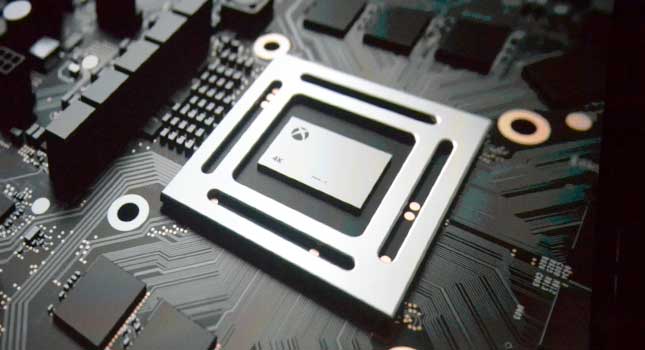Ben Newman
This year’s E3 has attracted a significant amount of buzz in both gaming and popular media. Whilst previous years have been stilted by stale announcements and awkward press conferences, this year has entertained with plenty of gameplay and, thankfully, new ideas. One of the biggest pieces of news from the conference was Microsoft’s reveal of their new console: Project Scorpio. Project Scorpio, essentially, is a games console ready for 4K, VR and, in some ways, an attempt to quell the growing prominence of PC gaming. Nintendo and VR have dominated the discussion of hardware running-up to E3, so it interesting how Project Scorpio has sapped a lot of attention from them. One thing’s for certain, it has put Sony on the back-foot despite their stronger game line-up and their announcement of the Playstation Neo going into 2017.
Xbox Project Scorpio reveal trailer:
Details And Explanation
Project Scorpio seems to be going all out with the quality of its components. The console will offer six teraflops of performance compared with the Xbox One’s 1.31 teraflops. Project Scorpio, then, will be roughly six times more powerful than the Xbox One. The console also offers 320GB/s of memory bandwidth. In essence, you can expect much better graphical fidelity and framerates, but also a much more colourful and detailed picture with 4K resolution. However, the prospect of Project Scorpio’s 4K functionality raises a few questions. It is unclear at this time whether all of the games on Project Scorpio will be fully 4K functional, or if only select titles will run at 4K, or perhaps games will intermittently enter 4K video quality at certain times (in cutscenes, etc.). It is concerning, too, that the hardware doesn’t exactly support seamless 4K quality. Even an NVIDIA GTX 1080 graphics card – which offers 9 teraflops of performance – struggles to maintain 4K quality. E3 hype can often cloud judgements, but it seems like the hardware isn’t powerful enough to have constant 4K resolution – the hardware does not add up to the expected results. You can expect 4K quality at lower resolutions, but don’t expect to be playing the new Forza at 4K on a 60″ television at 60 FPS. However, the most exciting part of Project Scorpio is the integration it offers with VR technology. This really is a statement of intent by Microsoft, Project Scorpio is their platform into the future of entertainment – VR.
VR Technology
VR really is the next step in entertainment and it’s relieving to see Microsoft taking it seriously. Sony has teased their VR quite extensively, so it seemed as though Microsoft were lagging behind in that regard. No information on VR support has been offered yet. It will be an interesting next few months for Microsfot and VR fans. Will Microsoft announce a partnership with the HTC Vive or Oculus Rift? Perhaps the new Microsfot HoloLens will have integration? Will there be an entirely new Project Scorpio exclusive VR headset? Oculus Rift already has Xbox One functionality, so it’ll likely be that which gets the nod, but you can never really know with the ever-changing nature of VR at the moment. Microsoft really need to get VR right if they want to compete with Sony and Nintendo as history has proved that the most powerful console doesn’t necessarily equate to the most successful.
A Return To Form?
A lot of noise has been made over the power of Project Scorpio and comparison’s with Sony’s PlayStation Neo has already begun, but the power of a console doesn’t equate to success. Project Scorpio will have to draw in really decent exclusives if it wants to compete with Sony who seem to be – much like what happened with the PlayStation 3 – building a late catalogue of much better exclusive titles. If we look at recent history of console sales, too, we find that a console’s power doesn’t guarantee sales. The PlayStation 2, for example, was technologically the weakest console of the PS2 and Xbox era, but it categorically won that console race. The PlayStation 2 dominated sales for that particular generation despite being the weakest console graphically out of the lot. The PlayStation 2 offered a cheaper price, better functionality and, most importantly, a better and more wide-ranging catalogue of games. Nintendo’s response to the Gamecube’s economic failure – the Wii – was to offer an affordable console. The Wii was much weaker than the PlayStation 3 and Xbox 360, but it was economically better than the Gamecube. Microsoft, essentially, need to ensure they get decent exclusives for their console and ensure that multi-platformed games run fluidly on their console.
The Games
Rather worrying, the head of Xbox marketing Aaron Greenberg has come out and stated that Project Scorpio will not have any exclusives. In many ways, the Xbox One has been held back by having releases on both Xbox 360 and Xbox One. Massive releases such as Dragon Age: Inquisition and Metal Gear Solid V: The Phantom Pain, for example, were released on both Xbox 360 and Xbox One. Dual releases such as this really prevented the Xbox One from moving into the future, it always felt shackled by the Xbox 360. It is doubtful Project Scorpio won’t have any exclusives, but if we take what Greenberg says as gospel then it hints at a worrying trend in console gaming. The “no one gets left behind” attitude has shackled the Xbox One and, to a lesser degree, the PlayStation 4. Microsoft really need to embrace the future if they want console gaming to stay competitive with the PC gaming market.
Projected Release Date
Project Scorpio will drop onto shop shelves and into living rooms in Q4 2017, just in time for Christmas. No price details have been announced yet, but you can expect it to be fairly pricey given the quality of the components.



